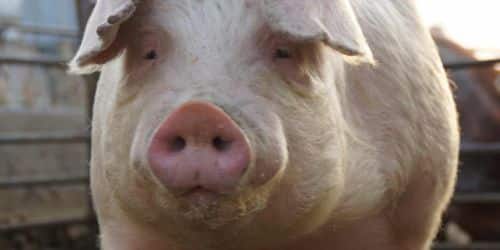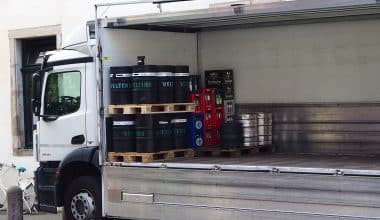Some breeds that spring to mind when people think of intensive pig farming are the Hampshire pig, the Duroc pig, and the Yorkshire pig. The Chester White pig, on the other hand, is an excellent choice for those looking to raise large, fatty pigs for commercial and domestic usage. One of the characteristics of a Chester white pig is that they gain weight quickly and are excellent to raise for meat.
But what exactly makes it so excellent, and more importantly, should a complete newbie buy in a Chester White pig? Let’s find out together as we discuss what we know about this Chester White pig.
The Origins and History
The Chester White pig breed, as the name suggests, is thought to have originated in Chester County, Pennsylvania. It was once known as the Chester County White, but due to its growing popularity, it was somewhat altered.
Its roots are thought to have occurred between 1815 and 1818 when breeders employed diverse strains of huge, white pigs from the Northeastern United States. These genes were then mixed with those of a fresh new breed known as the Woburn pig, which was imported to England by John Russell Duke of Bedford.
Regardless, this breed was formally recognized in 1848 when a judge witnessed two breeders bringing a Chester White pig to a county fair. Back then, the breed standard was a completely white body with medium-sized droopy ears. It quickly became known as one of the greatest breeds available, thanks in part to the nurturing attitude of the female Chester White pigs.
By the year 1884, a breed organization had formed, but it was not the only one to do so.
In fact, several groups arose up to the twentieth century, each preaching a particular set of values. The International Ohio Improved Chester Swine Record Association was one of the most significant contesting groups in the area. It was created in 1891 and was nicknamed “the Ohio Improved Chester.”
Read Also: Rabbit Farming in Nigeria: Everything You Need To Know
Despite this, several distinct breeds were added to the mix, resulting in various strains that all bore the same name.
This was about to change, however, when the Certified Pedigreed Swine Association was formed in 1997. It attempted to combine all of the strains’ records, legally awarding them all the moniker “Chester White pigs.”
Nowadays, the Chester White breed is regarded as one of the best options available. While it is not as popular as the Duroc, Hampshire, or Yorkshire breeds, it is nonetheless valuable for a variety of reasons.
For one thing, its pork genes make it a preferred choice for commercial crossbreeding operations. Second, it is by far the most durable of the white breeds currently available. Third, it can gain a lot of weight quickly, gaining roughly 1.36 lbs or 0.62kg per day and 1lb or 0.45kg for every 3 pounds or 1.4kg of grain that it consumes.
However, the Chester White pig’s pale appearance also works against it, making it more susceptible to sunburn. This implies that during the hottest seasons, you’ll need to provide it with lots of shade so it doesn’t suffer from heat exhaustion.
Why Are Chester White Pigs So Popular
Chester White pigs are genetically appropriate for farmers interested in raising pigs for commercial and domestic usage. One of the main reasons they are raised in such large numbers is their capacity to quickly gain weight and become fat.
In a single day, this pig can gain up to 1.36 pounds. It’s also incredibly cost-effective to raise because it gains one pound for every three pounds of grain it consumes. An adult pig that has been well-fed may produce between 1,100 and 1,400 pounds of meat.
This pig is also well-known for its exceptional mothering abilities. Chester sows have one of the greatest conception rates among pigs and will produce a large number of healthy piglets per litter, which is every breeder’s desire. This can be ascribed to the genetic infusion caused by crossbreeding. The muscle quality of Chester White pigs is also well-known among pig breeders around the world. It offers structural support and is responsible for the thick and meaty ham that results.
Their flesh also has a high-fat content, which makes it pliable and has a delicious flavor. It is equally popular in both household and commercial settings.
Finally, meat packers like Chester Whites because their white skin is easy to remove during the harvesting process.
Characteristics of Chester White Pig
Today, there are around two billion Chester White pigs in the world. This pig is really intelligent. It is omnivorous, like other pigs, and enjoys both meat (other animals) and vegetation.
Apart from its characteristic gigantic size, the first thing most people notice about Chester White is that it has all-white hair and pinkish skin that is easily sunburned. The pig has medium-sized ears that hang over its eyes.
One of the most outstanding characteristics of the Chester White pig is its snout. This is an essential tool for the pig since it uses it to discover food and smell. Because this pig does not sweat much, it prefers to keep its body temperature low by covering itself in the dirt.
When it comes to mating, the male Chester White pig, known as the boar, emits pheromones that attract females, known as sows. Their saliva contains these pheromones. When the female pig is discharged, she utilizes her snout to locate and mate with the potential partner. Another reason why the pig’s snout is one of its most crucial body components.
Read Also: HOW TO START A FARM: Step-To-Step Guide to Farming Success
An adult Chester White pig has 44 teeth, whereas piglets only have 28. When the pig is 12 months old, these 28 teeth come off. The teeth of this pig are very similar to those of humans. They are protected by enamel, which makes the teeth quite strong and helps to keep them disease-free.
These pigs chew their food just like humans. This is due to their digestive mechanism being very similar to that of humans, which means they cannot digest unchewed food. It must first be broken down in the mouth before it can be absorbed.
The Chester White, like all pigs, has four legs known as trotters. Many cultures consider these trotters to be a delicacy known as “pig knuckles” or “pig feet.” When a Chester White pig walks, its paw has four toes pointing downwards.
These pigs walk with their fingertips rather than their full paws. Two of its middle toes are employed, and the other two are used for balance.
Chester White Pig Feeding Habits
Chester White pigs, for the most part, will eat practically everything. Discover what pigs consume. They are very fond of table scraps like:
- Corn husks
- Potato skins
- Other vegetables
In the wild, these pigs primarily consume what pigs generally consume:
- Grass
- Roots
- Leaves
- Fruits
- Flowers
When confined, these pigs can be fed a variety of foods, including corn with a modest blend of vitamins and minerals and soybean meals. These pigs also have a voracious thirst for water, consuming up to 14 gallons each day.
Chester White Health Problems
Chester White pigs have a lifespan of 6 to 10 years. This makes the breed ideal for beginners because they won’t have to worry about having the same pig on the farm for up to 20 years, as is the case with most other pigs.
They are also extremely durable, yet if you are not careful, they can develop a vitamin C shortage.
These are the symptoms of a vitamin C shortage in your pig:
- Internal bleeding
- Swollen joints
- Skeletal muscle bleeding
If your pig suffers from these problems or other ailments, it must be hurried to the veterinarian quickly because it will not live long if nothing is done.
Based on their behavior patterns, you can detect if your pig has any of these diseases. If your pig is acting lethargic and weak, and they’ve recently lost a lot of weight, this could be a clue that something is wrong.
At the same time, you can tell your pig is in trouble if they start to get diarrhea and their coats become rough to the touch.
The Advantages of Raising Chester White Pigs
There are numerous benefits to growing Chester White Pigs that we have already mentioned.
Just to be clear, these are the primary advantages we believe you should be aware of before getting your first Chester White Pig:
- They produce a lot of pig and bacon, and the meat quality is excellent.
- They grow weight quickly, making them excellent investments given how quickly you can harvest their meat.
- The sows are excellent breeders that are born with natural mothering abilities.
- The sows reproduce swiftly as well, and they are famed for having a huge litter every time.
- They turn the majority of the food into a large amount of meat, which is a significant gain given the high quality of their meat in the first place.
- They are simple to sell on the market and command a high price, so you will simply recoup your investment.
The Disadvantages of Raising Chester White Pigs
As a new Chester White Pig owner, you’ll have to learn to live with the following drawbacks:
- Chester Whites, as previously said, will quickly get sunburned because they are enormous white pigs, thus they will require plenty of shade throughout the summer.
- Chester White pigs are prone to vitamin C deficiency. They will become lethargic and feeble as a result of this shortage, eventually passing out or becoming anorexic.
- They require a lot of space to dwell in as well as appropriate shelter during the summer to avoid getting sunburned.
- The only way to get a good night’s sleep is to have a good time.
Should You Raise Chester White Pigs?
Now the real question is whether you should invest your time and money in rearing a Chester White pig or another breed. The answer is actually fairly difficult to give because this breed has a lot of pros and disadvantages.
For one thing, it is not the most cost-effective breed to invest in, so if you don’t have the means to rear two or more of these Chester White pigs, you should probably go elsewhere for the time being.
However, if you invest enough in them, you will eventually receive your money back. As a result, it’s a bit of a two-edged sword.
For starters, they are expensive to acquire, maintain, and especially care for. They have a lot of needs, and the amount of food they can consume each day is basically non-existent.
What are Chester White Pigs Good For?
The Chester White breed’s strengths are mothering ability, durability, and soundness. Chester Whites have maintained their popularity among thousands of pig farmers. Not only are they preferred by farmers, but packers prefer white-skinned animals with greater muscle quality.
What is the Difference Between Chester White and Landrace?
The American Landrace is all white and extremely lengthy in stature. It is similar in color to the Chester White and the Yorkshire, but it has a longer body than the Chester and a significantly longer nose than the Yorkshire. Yorkshire ears are upright, whereas Chester White and Landrace ears like to point forward and down.
What Breed of Pig Grows the Fastest?
Durocs don’t remain this way for long; they’re among the fastest-growing native breed pigs, capable of developing into good, pork-weight carcasses in as little as five months.
How Many Piglets Can a Landrace Pig Have?
The Norwegian Landrace pig breed produces 9 to 8 weaned piglets per litter, two to three times per year. Within 142 days of birth, these pigs can reach a body weight of 220 pounds (100 kilograms).
Is Chester White a Maternal or Terminal Breed?
Chester Whites are noted for their mothering skills, durability, and structural soundness. Chester Whites have long been favored among pork producers due to their exceptional lifespan. These Chester Whites are preferred by packers because their white skin is easily removed during the harvesting process.
Conclusion
So there you have it, everything you need to know about the Chester White pig breed. It may not be the most popular breed, but it is really fantastic.
It’s less well-known and far more expensive to maintain, but if you do wind up investing money in it, you’ll quickly recoup your investment.
- BEST SMALL BUSINESS BANK ACCOUNT: Top 13+ Options In 2023 (+ No Fees Picks)
- Start Up Business Loans: Best Government Loans In The UK
- 18 Most Expensive Dog Breeds in 2023 (Updated)
- AVERAGE DOG INSURANCE COST IN 2023
- Online Casino Gaming that Will Make You Happy as a Clam and Hopefully Win You Some Money






